Excerpts from Jim Conrad's
Naturalist Newsletter
entry dated June 6, 2022, issued from near Tequisquiapan, elevation about 1,900m (6200 ft), ~N20.57°, ~ W99.89°, Querétaro state, MÉXICO
WORMWOOD
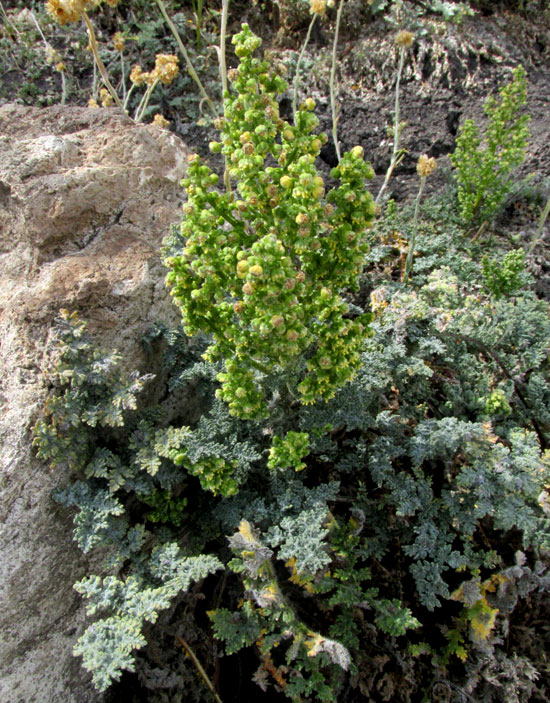
Here at the end of an exceptionally dry dry-season, when the rainy season still hasn't begun, though people expect it in middle or late May, unirrigated corn crops are drying up in the field, and even wild plants are showing stress. I think the plant shown above was one of those very stressed plants.
The stress is important to note because the plants profiled here look a bit different from those you may have seen in gardens, for it's a popular plant with many gardeners. These plants are much shorter and denser than most others -- severely stunted.
However, normally a plant's identity is mainly revealed through its flowers and fruits, which remain fairly constant even among sick individuals, while vegetative features drastically can change size and sometimes even shape. Though these plants' overall appearance was unfamiliar to me, maybe their flowers would reveal their identity.
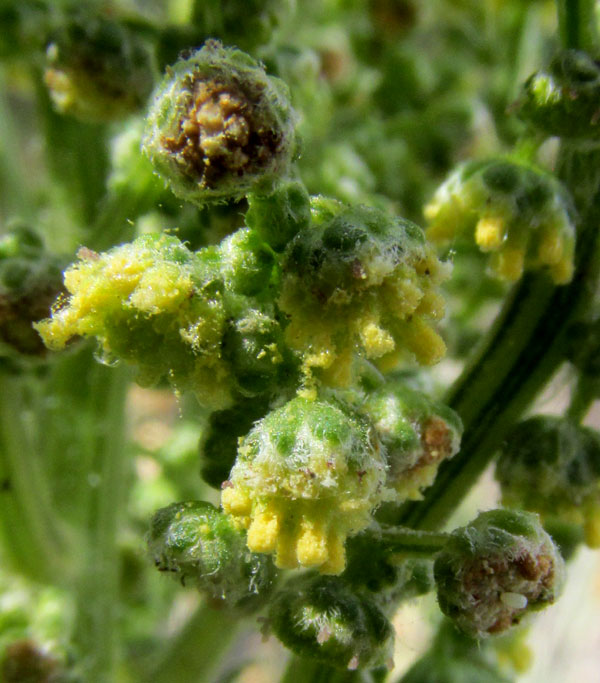
Above, several tiny, more or less spherical flowering heads, or capitula, nod downward, like upside-down, hairy, green cups, each filled with several florets, which are the actual flowers. The florets are yellowish, cylindrical items, and the upside-down, green, scaly cups are called involucres. Such arrangements occur only in the enormous Aster/Daisy/Composite Family, the Asteraceae.
The Aster Family is home to more than 23,600 species in 1620 genera. However, simply by noting that the above capitula are so small, bear no petal-like ray florets along their sides, and are so hairy, already we can eliminate the vast majority of other Aster Family species this could be. Another important field mark expressed itself only when the following picture was taken:
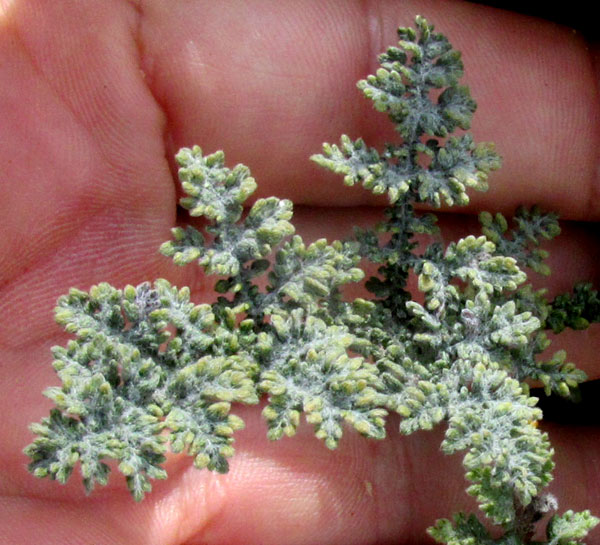
That's a compound leaf with many frilly subdivisions, which is very important to note, but an even greater give-away with regard to the plant's identity was that when the plant's leaves were manipulated for the photo, they issued a strong, bitter-menthol kind of odor. But note that this leaf is not fully deployed, nor were the others. You can see that each terminal segment ends with a bud-like structure, from which further segments will unfurl if given a chance. Maybe our drought has stopped further development. Still, it's clear that the oderiferous leaf is potentially 3-pinnatifid -- with divisions divided into divisions, which are divided into divisions again.
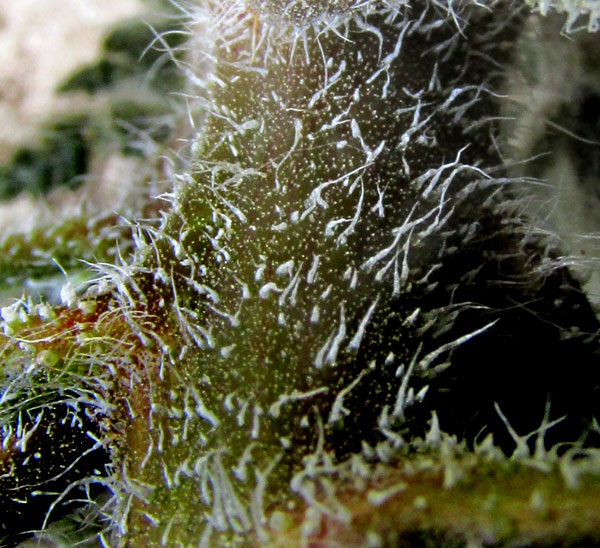
The stem was covered with the above broad-based, sharp-pointed hairs, giving the stem a silvery hue. Most stems of this species are marked with slender striations running up and down. Maybe this stem hasn't developed them because in the plant's stunted condition the stem is always in deep shade caused by leaves clustering so closely together, because of the drought.
Some of the flowers already had "set seed." The mature capitula were so tiny that with my old-man eyes I couldn't see much about them, but when a dry head was crushed and the fragments put on a fingertip, here's part of what resulted, with my thumbnail entering from the top:
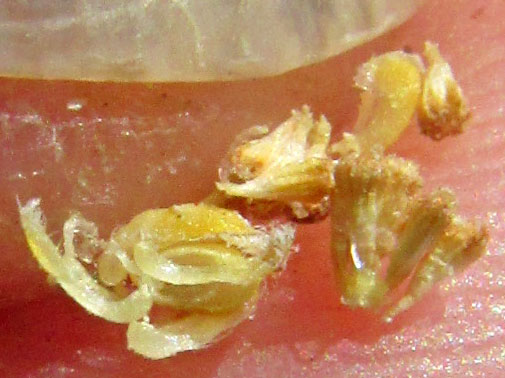
For the identifier, it's important to notice the two or three pale yellow, oblong items. They're the "seeds," which actually are cypsela-type fruits -- dry, one-seeded fruits that don't split open when mature.
All these details and more take us right to one of the most famous of all medicinal plants, commonly called Wormwood, Absinthe, Absinthium, and a lot of other names. It's ARTEMISIA ABSINTHIUM, a good old Linnaeus binomial from 1753, because Linnaeus knew all about it. It's a European plant that's spread across the world because people like its medicinal, culinary and ornamental features, and plant it, and it often escapes.
Its medicinal qualities are so legendary that it's hard to navigate all the reported traditional uses and recent extravagant claims. Wormwood is a big commercial item. At this writing, on the Internet, Amazon.Com sells 500 Artemisia absinthium seeds -- maybe a thimbleful -- for US $7.18.
The US's National Library of Medicine, considered a conservative, no-nonsense authority, hosts an online publication by Gaber El-Saber Batiha and others published in 2020, entitled "Bioactive Compounds, Pharmacological Actions, and Pharmacokinetics of Wormwood (Artemisia absinthium)." Batiha tells us that "Traditionally, A. absinthium has always been of pharmaceutical and botanical importance and used to manage several disorders including hepatocyte enlargement, hepatitis, gastritis, jaundice, wound healing, splenomegaly, dyspepsia, indigestion, flatulence, gastric pain, anemia, and anorexia."
In terms of clinical findings, the paper says that it's been documented that Wormwood possesses antioxidant, antifungal, antimicrobial, anthelmintic, anti-ulcer, anticarcinogenic, hepatoprotective, neuroprotective, antidepressant, analgesic, immunomodulatory, and cytotoxic activity.
The cytotoxic activity is to be noted, because it's also been found that long-term use of the plant's essential oil may cause toxic and mental disorders, which may include convulsions, sleeplessness and hallucinations.
If you read old novels, you may recall people in the stories drinking absinthe, in which Wormwood is an ingredient. It's also used as a flavoring in various wines and spirits. In England during the 1700s, wormwood was sometimes used instead of hops in brewing beer. You may be interested in Wikipedia's Absinthe page.
entry dated June 6, 2022, issued from near Tequisquiapan, elevation about 1,900m (6200 ft), ~N20.57°, ~ W99.89°, Querétaro state, MÉXICO
WORMWOOD STIGMAS
Earlier in the season than when the Wormwood profiled above was photographed, the next year I'm admiring newly developing flowers on a different plant and notice tiny, semitransparent, umbrella-shaped items emerging from the heads, shown below:
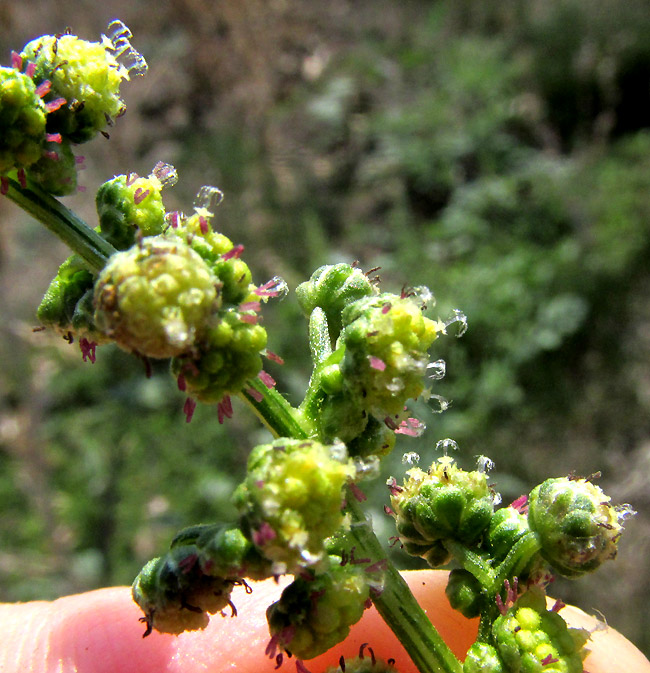
Bringing my little camera as close as it'll focus, here's what the umbrellas looked like close-up:
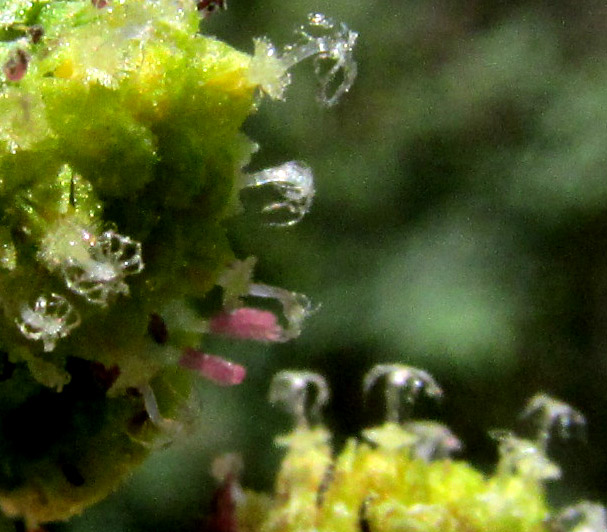
It was hard to believe that they could be stigmas, but what else in a Composite/Aster-Family flowering head could consist of several branches radiating from atop a stalk? Some hairs can do something similar, but these aren't hairs.
On checking into the matter, M.G. Maw and others back in 1985, in a work entitled "The Biology of Canadian Weeds. 66 Artemisia absinthium L." described the inner disk-flowers in Wormweed's heads as bearing both male and female parts, producing bell-shaped corollas (campanulate), and having "fimbriate stigmas." "Fimbriate" means having a fringe or border of hairlike or fingerlike projections, so our little umbrellas are fimbriate stigmas.
And why would a Wormwood bother producing such intricate stigmas? To expose more surface area to catch pollen grains wafting by in the air...